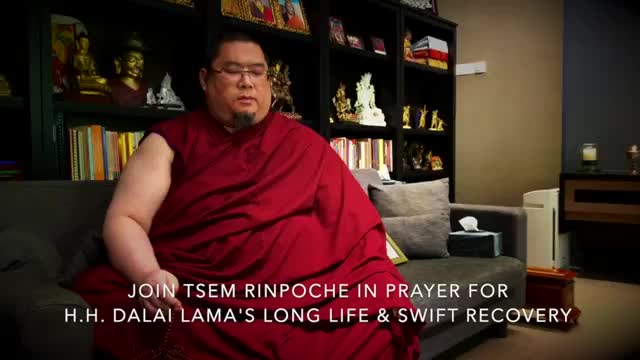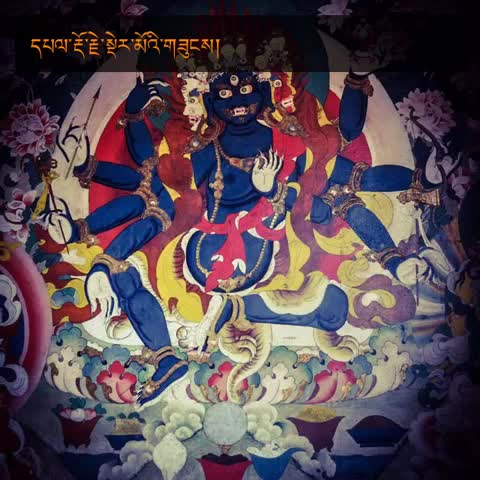Equanimity
A while ago I gave a spontaneous teaching in Dukkar Apartments.
Dukkar Apartments (DA) is the living quarters of both the Ladrang and Kechara Forest Retreat staff. Many of the hardworking Kecharians now live in DA where there are 30 cabins, a living room area, a kitchen and a place to eat. There are a few cabins designated for both guests and VIPs… those who wish to contribute towards the vision of building a retreat center away from the city.
I gave a talk on equanimity and asked 6 of my students to do a write up on the teaching and what they have learnt.
If you want to know more, take a read below!
Tsem Rinpoche


ANDREW
I have always “challenged” my thoughts and feelings to an almost argumentative manner which leaves me in a state of limbo and rarely black and white… always in the grey as a Dharma sister kindly pointed out. How I use unsubstantiated reason with myself can sometimes be detrimental and naïve and I find that I tend to also do this with others which points out the stubborn nature that I have with myself and certainly with others.
It may sound like I am beating myself up but on the contrary, I do have a point to this. I have been tackling with trying to write this article, an article I felt should be of a substantial and significant nature that I had forgotten to be honest with myself and why I was told to share how I feel and not write what I want others to read. It was certainly my ego at play and I know now why I was asked to write this and thus I will do so with the best of my instinctive nature when explaining and summarizing this teaching on a personal level.
The above is said in a manner in which to illustrate how my mind had been whirling with subjugated thought over a profound teaching by Rinpoche which was explained in great simplicity and subtlety for my impudence that I had lost the true essence of its clarity. I am, having battled some demons, compelled to share this teaching in the hopes that it too, may ring that familiar bell of clarity for those of you reading this.
This particular teaching touched on complex subjects long debated and often contemplated on, like Renunciation, Bodhicitta and the Wisdom of Emptiness, also known as the 3 Principle Paths. What struck me was how inter related and certainly codependent these three were and these are some of the points I had realized from the teaching!
POINT ONE:
Attachment as something or someone we hold on to because there is a gain to be had and why it is detrimental to our spiritual growth.
The example of relationships as an attachment was highlighted in the teaching as it was relatable to all. Relationships can be seen as a substitute for a feeling we want, we miss or we wish to have. For me personally, being in a relationship gives me self worth. It makes me feel that I am wanted and loved. Or so I tell myself! This warped perception is precisely why, in my case, a relationship can be seen as an attachment because it is used to fill a void within me. It is a want, a need and is something I gain from! All these point to my blinkered focus upon the relationship as all important because I get a benefit out of it and that is precisely how my selective mind works. However, it is not the person I am having a relationship with nor is it the relationship itself that I am attached to and would do anything for or to keep per se. It is my grasping for self worth that makes me think I need the person or the relationship. If it doesn’t manifest in the form of a relationship, my want of self worth could well manifest in an entirely different attachment, depending on how my karma manifested and how my deluded mind latches onto a scapegoat emotion that is convenient.
There are varied reasons why someone jumps into or longs for a relationship and more often than not, it is to get some form of self benefit. It could vary from as simple as not wanting to be alone to as complex as a need to be controlled or manipulated. Whatever the reasons or so called gains we think we are getting, it really is just in the mind. The grasping comes from us and us alone and hence, if we are able to cut this off we would then begin our first steps to non attachment.
It is this very grasping that we feed that creates the karma for us to continue along this slippery slope to karmic oblivion. As the more we think we are fulfilling a want, we are actually making it stronger because we failed to address the real issue at hand… which in my case is the lack of self worth.
Thinking about this deeper makes me realize how silly this actually sounds. If I want self worth, I should be making myself more appealing in my own eyes and not using another person or situation to show me or tell me that I am worth something. This is why, in my particular case, the pursuance of any form of relationship to satisfy this self worth can never be filled because it does not deal with the root problem which is my own inability to recognize my own positive traits and dwell upon my shortcomings instead. If I am to not even recognize this in myself, being of a selfish nature, how else can I see it in others? Therein lies the problem. This realization to me is quite shocking in a positive way as it makes me see how others have been viewing me all this while. And if I can learn to love myself more, perhaps I can learn to love others better too.
POINT TWO:
This brings me to the matter of having equilibrium and why it is important as a method for our current mindset or spiritual maturity.
For me personally, having equilibrium is in a way eradicating duality or the unbalance we create through our attachments. For example, if I again take the example of my relationship and what I feel it gives me, and because of this gain, I tend to put my partner on a pedestal. And because I cannot let go of this so called grasping which makes me focus purely on my partner, the practice of equilibrium actually gives me a method to elevate others around me to the same perception I give to my partner without having to “give up” my relationship. It sounds like a cop out? In a way it is but at least in this way we actually train our mind to have equilibrium which can also permeate to other aspects of our lives or other “attachments”. For example, if we cannot stand a certain idiosyncrasy of a person and instead of feeling angry or frustrated at that person because of our attachment to having things a certain way or to the projection we have on others, we learn to accept them because we care enough to give it a balance.
How do I do this? Quite simply try to live by the phrase, “fake it till you make it!” Sounds non Dharmic one may say, but on the contrary it is a very Dharmic statement as it construes practice and practice is one of the key elements in our spiritual journey. It is a form of reprogramming our minds to think the “right” way as opposed to the “selfish” way.
Does it work? Logically, if bad habits are formed by repetitive routines that forms into a subconscious pattern, so can the opposite. Hence if I practice, equilibrium and eradicate duality and treat everyone equal to how I treat my partner in my relationship, I will eventually learn to love everyone equally and this creates the causes and sows the seeds for me to develop this further in my future lives. Because what we are attached to now is a reflection of what we were attached to in our previous lives and henceforth in our future lives if we do not break the cycle now.
POINT THREE:
It is not too late and if it was, there is no point in enlightenment and hence why even believe there is a Buddha!
There is, I believe, a point where we “start” from. It is said that there is no beginning and no end but from where we stand at any one point, there is always a start of something as time moves on in a continuous motion. This “starting” point is where we can make a conscious mark whereby we begin with the accumulation of positive actions towards a goal, the goal of liberation.
In our Tibetan Buddhist tradition of relying on Guru Devotion vis a vis our Guru, we are taught to perceive our Guru as faultless and as the embodiment of the Three Jewels. Our Guru would even compassionately use his own body to manifest illness just for us to practice care and compassion to counter our selfishness whilst using whatever perceived “persona”, be it wrath, kindness, indifference, anger, humility, regret as a mirror to our own, just to train our minds.
How can one bridge this personification of enlightenment if we cannot perceive that we too are capable of achieving such state of liberation? And if we believe in this we believe in the fact that we can be liberated and that the state we are in now can change and hence how we perceive ourselves NOW in the very state we are NOW in, can and will change if we want it to change.
This is why we should use our opportune conditions now to practice and to sow the very seeds that will fruition to a potential state whereby we can gain some realizations and attainments in our spiritual journey.
POINT FOUR:
How, through skillful means, even such profound teachings such as the Wisdom of Emptiness could be conveyed to suit our petty and closed minds.
Though it was just a mere drop from a vast ocean of knowledge and wisdom, the subtle imprints on emptiness that was shared with us all via the teaching has made me further realize the infinite compassion that stems from Rinpoche’s focused and unwavering mind.
To make us see that our attachments are not what we perceive them to be. That the importance and priority we put on them is but a waste of time for everything in samsara is but a delusion and the only truth and light is in the embodiment and purity of our Body, Speech and Mind.
To even give us the methods to help curb this grasping by making us create the causes for us to receive further teachings and sow the seeds of good karma through our actions that it may fruition as merits to receive more Dharma and further improve our mind. And this is done purely because we cannot and will not bend to the truth but remain steadfast to our stubborn and selfish nature in protecting our deluded ego!
I do not profess to be able to perceive emptiness or fully understand it for now, but I do know, that I am much better off with than without Dharma and that this spiritual journey is certainly not in vain. However little I have perceived of this profound teaching is indicative that I am still able to absorb but I have a long way to go… but at least it is the right direction!
***

PASTOR JEAN AI
Title: Making attachments unnatural
A few nights ago, Rinpoche gave a profound teaching on the third of the Three Principle Paths, which is emptiness. Using relationships as an example, Rinpoche showed us through logic how chasing after attachments creates our samsara, therefore prolonging our suffering. Rinpoche also showed how clinging on to our attachments will hinder our spiritual progress by concealing the true nature of phenomena, therefore preventing our realisation of emptiness and ultimately, alleviating suffering for ourselves and others.
Why do our attachments lead to our cycle of deaths and rebirths?
Rinpoche used relationships as an example of how people chase after and reinforce their attachments. When we are in a relationship, we show more love, care, help and attention to our partners, over and above everyone else. In some cases, we cherish our partners at the expense of our friendships and families, just to spend time with this one favoured person. Why? Because they make us feel special, safe, loved, cared for, desired, etc. more than anyone else does.
In this way, the relationship is actually a vehicle to what we really want; the real attachment is not to the relationship itself but what the relationship can give us. Relationships therefore reinforce our selfishness because we maintain it to continue receiving what the person can give us; we need the person to give us what we want.
Rinpoche said that if we really wanted to get into relationships, it should be about what we can do for the other person, and not what the other person can do for us. If we need the person we are with, it’s not a relationship but a prison because we are forced to act in a certain way, even though we would not normally do so. We act in that manner anyway because the short-term consequences are “pleasurable” to us.
This kind of strong desire to experience that pleasure and fulfil our attachment creates strong imprints in our mind, and reinforces our already present negative tendency to chase after our attachments.
Reinforce? Already present? Yes, because our present lifetime is not our first spent chasing after our attachments. In our previous lives, when we strove to fulfil our desire to be in relationships (for example), we created the causes to be reborn into environments whereby we were told our attachment to favour one person is ‘good’ behaviour. This cycle happened so many times, our behaviour of clinging on to and chasing our attachments became natural / habituation.
From the perspective of Western psychology, behaving in a routine manner that is often subconscious is known as habituation. This kind of habituation can be positive or negative. In the case of samsara, we can look at our cyclical rebirth as a series of repeated negative habituations – in each consecutive lifetime, we repeatedly commit negative habits (chasing after attachments) which creates the causes for us to be reborn in the same environment encouraging the same negative behaviour and attitude.
Therefore over countless lifetimes, we have continuously created karma for ourselves to be reborn in environments where we live under the false perception that we need our attachment. How and why this perception is false I will explore later. What we need to know is that in the process of working to fulfil our false perceptions, we create even more negative karma to be reborn in the same situation again, to chase after our attachments to create even more karma to be reborn in the same situation…again and again and again (hence the prolongment of our suffering).
Although Rinpoche used relationships to demonstrate how attachments can prevent us from spiritual progress, attachments do not necessarily have to be with relationships. Attachment can be towards food, money, fame, reputation or power – it is not the object or action that is in question, but our attitude towards the object or action. Therefore, in the same way a person can be attached to relationships because of what they gain from it, a person can be attached to money because of what they gain from it (e.g. power, status, nice cars, big house).
Is this behaviour bad? What’s wrong with having attachments?
More importantly, we should ask – is there hope for us to get rid of this kind of attitude and to end our samsara? In short, yes because although we have negative attitudes, we can also cultivate positive ones to a point where those attitudes become natural to us. Therefore the Dharma is the systematic retraining of our minds to correctly view what is beneficial and what is detrimental to our spiritual progress, and to act accordingly. Using the Dharma, we can break our negative attitudes which result in that tiresome cycle of death and rebirth (samsara).
One positive attitude we can start to develop now is recognising the value of not having attachments, and Rinpoche kindly used himself as an example. Rinpoche said perhaps many lifetimes ago, he was like any other person who is attached to their partners, their wealth, their fame, their reputation. However, perhaps in one of those lifetimes Rinpoche had a particularly nasty break-up with his partner and that led him to meditate on suffering. Perhaps Rinpoche’s meditations in that lifetime planted the seed for him to renounce relationships.
In his subsequent lifetimes therefore, Rinpoche’s meditations created the karmic results of eventually removing of his attachment to seeking relationships. After many lifetimes of retraining his negative attitudes in this way, Rinpoche developed positive ones like the renunciation of his attachments.
In effect, Rinpoche retrained himself to find other things natural in the same way we find our attachments natural. For example, chasing after attachments is not natural to Rinpoche but compassion, helping others and renunciation is.
In contrast, we laypeople spent our previous lifetimes cultivating our negative attitudes. Instead of creating the karmic results to experience renunciation now, we created the karmic results for us to experience more desire, attachment and suffering. Hence in this lifetime, negative habits like chasing after attachments will be natural for us and positive ones will be less natural.
Therefore to end our own samsara, it is about retraining our minds to value different phenomena. We should retrain our minds from one that values negative attitudes to a mind that values positive ones. Once we develop a value for positive attitudes, actions like renunciation no longer have to be a conscious act. Instead, being unattached will come as naturally to us in the same way that being attached currently does.
Why is our perception false? Aren’t our attachments real?
Does that mean we have to break up with our partners now? Rinpoche said actually, we shouldn’t dump our partners or seek to renounce all of our attachments. We have to be realistic and realise that such grand gestures are not sustainable for practitioners like us who have spent many lifetimes reinforcing the false perception that our attachments are real.
Rinpoche explained that in reality, our attachments exist only in our minds and it is our craving for the object that makes it become real. Because of the environment we are born into (as a result of the karmic causes we create in a previous life), we are “nurtured” into thinking our attachments are good and we are encouraged to go towards them.
When karmic causes prevent us from acquiring those attachments, we suffer. Alternatively, when we have the karma to acquire those attachments, we develop a craving to keep acquiring them because we are told that is right and we should get more of it. When we experience the suffering of non-acquisition, or the pleasure of acquisition, the attachment becomes real to us.
One key phrase in realising how false these attachments are is “to us”. What we value as an attachment is not necessarily what another person will value – not everybody values relationships, food, sex, money, health, etc. in equal measure. If the attachment were inherently precious, shouldn’t the object be equally valued by everybody?
Since the attachment itself is lacking any true inherent value, the “realness” of the attachment is actually non-existent – that is, the attachment is false. What makes it real is our karma, created in previous lifetimes, to lead us to desire the attachment to the point we have to act on it, to make it real.
Another method of evaluating the falsity of our attachments is by looking at the way in which our attachments arise. They arise because we see ourselves as permanent entities – I am Jean Ai, I am Asian, I am female and therefore I like this, and not that. Viewing ourselves as permanent entities is dangerous because one day, the karma for us to exist as we think ourselves to be will run out. Therefore since we are not permanent, our attachments are not permanent also – that is, there is no Jean Ai who exists in the way I think she does, who likes tomatoes and chocolate, and hates celery.
Are our attachments bad?
This won’t be the answer most people want to hear but yes, our attachments are bad for us. As long as we hang on to them, we will continue to reinforce the illusion that what we desire will make us happy, and we will carry this illusion on with us into our future lives when they will continue to cause us suffering.
Rinpoche said he knows it is hard for us to break this attitude of preferring some people or situations over others, which has developed and been reinforced over countless lifetimes. Therefore for those who are serious about their spiritual practice, Rinpoche gave us another method to retrain our minds until renunciation comes naturally to us. Rinpoche said he is not asking us to go cold turkey, and to dump our relationships and become ascetics (although that would be best for us!). Instead, Rinpoche said, we should try and create equilibrium.
Again using relationships as an example, let’s say we have a scale of one to 10. At Level 1, we treat the person with “ignorant indifference” and at Level 10, we crave and will do anything for a specific person’s attention. Rinpoche said instead of cutting off anyone who is at our Level 10 and caring for them less, why not try and treat everyone around us at Level 10? And that makes perfect sense – if you have the capacity to care for someone at Level 10, then it means you have the capacity to show that much care…so why not show that much care to many, many more people?
How does equanimity help us?
We should recognise that the method Rinpoche described will NOT instantly and completely get rid of our attachments. Rinpoche was teaching us how to recognise we do have attachments, and provided us with an alternative, but symptomatic treatment to get rid of them. By us creating equilibrium and being kind to everyone instead of just one person, we practise equanimity consciously. When we practise equanimity consciously, we plant the seeds for us to practise it again in future lifetimes, until it becomes natural.
When practising equanimity becomes natural, we will abide in a state of non-duality, without preferences or attachments. Non-duality is the way in which we view all phenomena equally, regardless of what we stand to gain from it. It is, in fact, the opposite of being attached which is an attitude fuelled by the benefits we derive from maintaining that attachment.
Again we can use relationships as an example of how attachments hinder our realisation of emptiness. When it comes to relationships, Lama Yeshe summarised this by teaching,
“Consider your relationship to friends, enemies and strangers. Your craving over-estimation of one person, your hatred of another, and your ignorant indifference to yet another come from your own three poisonous minds of desire, hatred and ignorance.”
(Source: https://www.tsemrinpoche.com/tsem-tulku-rinpoche/inspiration-worthy-words/great-excerpt.html)
When we have an attachment, we have a “craving over-estimation” for that person or thing over everyone else. In having this preference, we are actually rejecting equanimity because our preferences create two levels – what we like, and what we like less. Using wealth as another example, when we favour one state over another (rich vs. poor), we deriving this preference to be wealthy by projecting a value on money as a measure of happiness. Rinpoche’s alternative method to renunciation trains us to let go of this preference, until equanimity becomes natural.
In rejecting equanimity, we are also behaving in the exact opposite manner necessary to develop as bodhicitta, a state in which we have equal compassion for all sentient beings. Bodhicitta is one of the other Three Principle Paths necessary to gain enlightenment and ultimately, end to our and other people’s suffering…after all, have you ever known a Buddha to be selective in their compassion?
Thus, Rinpoche effectively said we should fake equanimity until we develop real equanimity. Developing such equanimity (or non-duality) will help us to gain realisation of emptiness – that all phenomena is devoid of an inherent existence / value – without making a conscious effort to try and understand it.
At this juncture, it is important to note the role of guru devotion in our Dharma practice. For many people, we find it hard to be kind to everyone without agenda and selectivity. Focusing on our gurus’ compassion and generating gratitude trains us to be kind to our lamas, to repay their kindness to us. From our lamas, we can then extend this kindness to include people around our teacher and around us, and eventually to people we do not like. In this way, our lama becomes the focal point for us to develop non-duality in how we view others, and our lama trains us to give up our attachments and comforts in order to repay his or her kindness.
Rinpoche ended this most profound Dharma teaching with a request. Rinpoche asked us to put the teachings into practice, saying that “All dharma teachings should be taken as personal advice”. Rinpoche said that if we really wanted to suffer less, we would come away from the teaching not singing praises about its profundity, or viewing it as just another intellectual debate or eloquent speech. In order to for us to experience the benefits of Rinpoche’s teachings, we had to put it into practice.
That practice is our Dharma work. Dharma work challenges our attachments by acting as a constant reminder of non-selectivity – we have to be kind, patient and generous to everyone we come across, because all beings are suffering. For those who view Dharma work as difficult, Rinpoche said that Dharma work is a sacrifice only when we are attached. When we struggle, it means that we are struggling against our attachments. Therefore to commit to Dharma work full-time is really to commit to a full-time battle against our attachments…and having understood how attachments prolong our suffering and hinder our realisation of emptiness, why wouldn’t that be a battle to engage in?
***

MARTIN
Rinpoche’s talk on the 3rd Principal Path
Recently Tsem Rinpoche gave a teaching at Dukkar Apartments that touched on a number of subject matters that go directly to the progress of our spiritual practice. At its core the teaching was a preliminary explanation of the Third Principal Path (Wisdom of Emptiness) but in the process of elucidating the crucial points, many other topics of the Dharma arose as well, such as Attachments, perception of a Self expressed in our dualistic view, Habituations and how our actions creates the karma for wrong views to persist, Bodhicitta and others.
Rinpoche began by speaking about relationships and how we naturally favour those we love in our thoughts, in our actions, in our speech and with our time, effort and so on. However, the subject that Rinpoche was focusing on was not about relationships at all, but using relationship as an example of our Attachments. Our attachments come in many varied forms and we pursue them thinking of them as genuine methods by which we can attain happiness. In that, we are mistaken and as a result of acting on our mistaken views we not only create our own field of suffering in this life, but in fact create the karma that keeps us within a vicious cycle of suffering instead of getting us out of it. Unknowingly we act on a habituated instinct and we become entrapped in a maze of mistaken views. What Rinpoche taught that night was a key insight into that wrong view and also the correct method to reverse the process that takes us deeper into our deluded state.
Relationships as an example of our Attachment:
We pursue Relationships because, just like other things such as Money, Fame and a Sense of Security, we feel it is what makes us “happy”. However we fail to see that our need for a relationship is just another expression of our mind grasping at its attachment to a desire to be happy albeit by following a wrong method. Having attachments gives us a desperate feeling of longing such that we feel we must fulfill that longing in order to be happy. But immediately we are wrong because the relationship itself is nothing other than our attachment demanding attention. By addressing the relationship and not recognizing that it is our attachment that gives us that longing, we address the symptom rather than the actual disease and in that way we never get cured.
So if it is not a relationship per se that we grasp, then what is it? The answer is the pursuit of a relationship is simply our mind acting out its desire to familiar tactile which relationships (present, immediate past and those in past lives) provide – that tactile feeling of touch and intimacy that filled our own senses in a way that makes us crave for more (and hence an Attachment). Of course we wrongly equate having that feeling to being in a state of ultimate happiness. That kind of happiness is temporary at best but we fail to recognize that and therefore we keep pursuing “it” However not recognizing “it” or more accurately our craving for “it”, we mistakenly assume that it is relationships that makes us happy. In fact that is not correct, and it is not relationships as such that we seek, but the fulfillment of that tactile feeling again. (During the teaching Rinpoche jokingly remarked that some of us are preoccupied with imaginary relationships and while that was said in humour, it was in fact very profound. Ultimately a relationship is not so much a correlation between our lover and us as it is between our attachment and us). Chasing a relationship is nothing more than our mind selfishly seeking to please itself. Hence from the very start we view a relationship from what and how we gain from it. Getting that relationship and its corresponding intimacy reinforces the wrong view because for a time, we feel happy. Not getting the relationship also reinforces the wrong view and intensifies that need to be fulfilled. Both are wrong and in fact it has nothing to do with the relationship at all.
However, the very act of seeking the fulfillment of our attachment and even the act of going through the motion of acquiring relationships, all based on a mistaken view creates that karma for the mistake to persist and for the attachment to fester and intensify. And it is this intense karma that we carry forward into our next lives and act out in pursuit of our attachment by looking for one lover after another, and one relationship after another.
Not realizing that we are driven in fact by our attachments (and realizing also that the idea of a relationship giving us happiness is false) we say that we want to be in a relationship with a person out of “love”. But in fact it is not so much love but the force of habituation playing itself out. “Love” is not a self-existing phenomenon because if love does exist on its own and resides independently within us, it follows that we should be filled with such love and affection such that we would be able to help but express that love equally towards everyone. It would be all pervasive and yet it is not. In any relationship the tendency is to favor the object of our “love” in ways that we do not apply to others. So, if it is “love” why is it that we love only a selected one or few and not all?
Here we get a glimpse into the workings of a mind filled with wrong views. The “love” we refer to in a relationship is in fact our habituated mind justifying all kinds of methods to fulfill its own cherishing. The truth is, we only love a particular person because he or she fulfills our attachment. We do not love a person for any reasons that are completely independent of our self-cherishing and how that “love” benefits us. In the end, that “love” is a means to an end, the end being to fulfill ourselves. If we do not love everyone equally it is because we do not receive the same fulfillment to our self-need from everyone equally. And ultimately we only “love” the one who facilitates the feeding of our attachment. Therefore in fact the object of our “love” is the instrument by which we fulfill ourselves. Often it has little to do with the object of our love and nothing at all to do with the relationship which has no reason to exist other than a cover for us (which we may not even know) to receive that which we crave – the tactile feeling and intimacy which we mistakenly call happiness.
The mind plays out its attachments in other forms as well. To see it from another perspective, we will use cars as a second example. It is common for people anywhere in the world to prefer a Mercedes/BMW/Porsche over cheaper vehicles such as Kancil and Kembara (or similar locally assembled and basic cars in your country). Both imported luxury vehicles and basic local vehicles serve the same purpose and in fact in more ways than one, they both serve their functions equally well. And yet like many, we are more inclined towards a luxury car, not for itself, but because it fulfills our need to be seen as being successful and wealthy, again thinking that this is what makes us happy (yet another Attachment). So in our mind we equate the good opinion of others towards us as being in a state of happiness. Again we are wrong but failing to see this we keep pursuing the acquisition of expensive cars, as a means to secure positive opinions of others towards us. The value of our happiness becomes synonymous to the value of a luxury car and because the perception of the value of a car changes all the time, we never really attain lasting, permanent happiness through this means. The evidence that a luxury car or indeed any car or object makes us happy lies in the simple fact that if that is true, then once we have that car or object we ought to be happy forever. But that is not the case. Therefore it is not the car that we pursue but the fulfillment of another Attachment that drives us.
Because of our perception of what a luxury vehicle provides, we are willing to do more for it, pay more for it, give it more care and hold it in higher regard. It is not the car, but how it feeds our attachment that we treasure. Similarly in a relationship we give more care and attention to the object of our love because just like the luxury car feeds into our attachment to be well liked and respected, the object of our love in a relationship feeds into another form of attachment.
These two attachments and many more that expresses themselves in “innocent” ways dominate our lives and we expend most of our time and energy seeking them. And yet we are never happy for long. Our attachments to these things are in fact our attachments to something more. In fact these things such as relationships, cars, houses and positions are all empty in themselves.
Our Dualistic Views:
We saw earlier how we treat the object of our “love” differently to other people in our lives. This is a dualistic view and in fact we have this dualism in all aspects of our lives because indeed, we have attachments hiding in all aspects our lives. It might not even be wrong to say that our life in samsara consists of a series of interlocking and a cross-weaving of attachments (all feeding into each other as we act on them) that we do not recognize. And what come “naturally” to us in chasing samsaric pursuits is in fact the old attachments seeking to replay itself out again by a force of habit, or by the force of karma.
We never question our habit of looking at people and things from the basis of whether we like or don’t like them. And because we don’t question them we allow ourselves to act on this dualism and as long as we maintain a dualistic view, we are in fact pursuing an attachment and by default allow the attachment(s) to linger, fester and grow. When we do not look at people as being equal and by the way we do not treat all people equally this duality enhances our wrong perception of the reality of all things.
When we practice duality or bias we are in fact expressing and reinforcing thoughts and actions that arise out of our self-cherishing – we pursue what fits our attachment and we avoid what does not. In fact just by having a dualistic view gives us a mistaken perception that a Self exists because likes or dislikes is referenced to a self. Without the Self and its attachments, how can there be likes or dislikes?
By continuing to think in this bicameral fashion we reinforce it and create the imprints and the force of habit for that self-cherishing to repeat lifetime after lifetime. We may say we cannot help ourselves and we cannot avoid having preferences and it may appear so because indeed we are born with imprints from our past lives’ repeat of dualistic view. And yet this is not true because if it were true then everyone would be born with the same attachments because everyone seek the same happiness. Referring to relationships as an example again, not everyone grows up with the same desperate need to seek a relationship and in fact there are those amongst us who naturally live quite happily without. Why the difference? The answer lies in the fact that the attachment (in this case, the attachment to what a relationship fulfills) is not equally present or strong in everyone. Some attachments are strong because they are reinforced over many lifetimes. Others are weak because they have been countered over many lifetimes.
The fact is, we do not live only one lifetime. If in this lifetime, we habitually reinforce our self-cherishing nature – the nature that compels us to seek out what we feel we need – then this is the nature we are born with in our next lifetime. This is the force of karma at work. It may express itself in another way but it can all be traced to having deep-rooted attachments cultivated over and over again. However, if we become aware that our nature that practices duality arises out of a habituation of self-cherishing then we can progressively change it. Someone who becomes aware that their attachments are the result of a karma that arises out of repeatedly acting out a wrong view, he or she will not want to keep creating this karma that ultimately leads to suffering.
Looking around, there are those who have a desperate need for a relationship and then there are those who don’t. The difference is explained by them having different karma. Karma in turn is developed by the thoughts and actions we cultivate. If in his or her past life someone realizes that a relationship is not the correct method to attain true happiness and the person stops pursuing that wrong view, then the karma that drives a person to have that wrong view and seek a relationship is this life is reduced or eliminated. The thoughts and actions we cultivate in one life develops into a habit that drives our character and inclination in the future lives.
This would also explain why a Bodhisattva like Rinpoche does not have a desire to fulfill his own desires but instead feels compelled to focus on the welfare of others instead. It is a habit that has been cultivated over many lifetimes. It is the opposite side of the same coin – lifetime after lifetime of focusing away from the self and on to others. Just like our force of habit drives us to chase our needs and try and fulfill our attachments, like that, the many lifetimes of practicing care for others drives Rinpoche to act out of compassion for others. The opposite of care for ourselves is care for others that, when practiced repeatedly and reinforced over time, creates a mind that cannot help for look out for others. It is a mind of Bodhicitta that has been nurtured and practiced over and over again until it becomes natural.
And so, we see that the same mechanism that drives us deeper into samsaric suffering can also drive us out of suffering. The vicious cycle of self-cherishing can be transformed to be a joyful cycle of Bodhicitta – compassion for others replaces the need to fulfill ourselves. But before this healthier cycle can be initiated it requires: awareness; a decision to apply it (and not just comprehend it intellectually); and a proven method of application.
We know that Bodhicitta can be cultivated as a direct antidote to one’s suffering that arises out of constantly chasing desires which in turn arises out of a habituation to fulfill the self by the wrong means. The bottom line is, it is what we cultivate and the kind of karma that we consciously create that drives us one way or another. As earlier said, the mechanism is the same and if the mechanism has work efficaciously to drive us deeper into our suffering state of unending and unfulfilled attachments, then it can also work just as effectively in reverse.
Generating Bodhicitta as a counter-measure:
That “method” is what Rinpoche spoke about during the teaching and Rinpoche expressed it as practicing “equilibrium”, which is the means to create a counterforce to the habituation that keeps driving us down the path that reinforces our attachments. Practicing equilibrium is to develop the habit of seeing people and treating them equally so as to neutralize our dualistic view, which we have seen reinforces our attachments. At the moment, very few people can immediately realize Equanimity and so we have lead into it by creating the causes for that realization to occur. But for now, we need to proactively rewire our instincts and consciously develop a new habit which is to equilibrate all people and all things, treating people and things we like the same as those we do not like as much or at all.
It requires an element of doing what may not come naturally at first. Referring to the relationship example again, we have to expand our love for one to include all even if it is a conscious effort that may not be natural. To express it differently, we have to “fake it until we make it”. On the face of it, faking something means it is not real. But in fact, neither is our “true” love for another. That “love” is not real either as we have examined. That “true” love arises out of an attachment that latches on to an external factor as a method to fulfill the mind’s self- cherishing. Similarly, “fake” love can latch on to external factors with greatly enhanced foci, as a method to fulfill the mind’s Bodhicitta. Both arise out of conscious decisions once we become aware of their true natures.
Whilst the most efficacious method is to renounce all that fills our senses and all that we desire (knowing them to be empty), it is not an easy task for the untrained mind to practice renunciation correctly without falling into the trap of self-denial. In fact unless we can eliminate a self-cherishing mind, the more we focus on a desire as a means to renounce it, the more life we breathe into that desire.
Practicing equilibrium is the method to train our minds to look at things from another or more accurately, an additional perspective. We focus more on just the self and develop the habit of focusing out on others and equilibrate our desires and preferences. The importance of developing this new habit is that it creates the causes to counter our attachments and it creates an alternative force that drives us to focus away from ourselves. If it has taken more lifetimes for our attachments to crystallize, then it may take just as many to counter it. However it must start from this lifetime, from this moment when we become aware of what truly drives our thoughts and actions.
For me this section on “faking it till you make it” warrants considerable attention. Because when we think about it, everything we are predisposed to think and do, the mind regards as “true” and conversely, everything we are not predisposed to do, we regard as “fake”. The reality is, there is neither “true” nor “fake” in anything; all of it has to do with our predisposition. And so it is the correct predisposition that we must cultivate. In this way we are attending to the erstwhile mentioned disease and not the symptom.
In conclusion:
In summary, much of how we think that drives the way we act is the result of our mistaken views that fail to see our attachments as hollow. The things we chase after when working out of our attachments are themselves hollow and it is only our desire for them that gives them life. They are not real and neither is it true that pursuing the fulfillment of our attachments can create the happiness that we seek. We are attached to many things (such as relationship, money, fame, luxury and so on) and yet time and time again we see that even if we succeed in securing these needs, we are still not happy. In fact, for some, it is never enough and the pursuit never ends. Strangely we don’t stop pursuing them and this happens because the karma we create by repeating these thoughts and actions keep us in a vicious cycle of wrong views and suffering.
Knowing this, we have to create new measures by which the karma to keep pursuing the wrong view loses its prominent hold on us, and is eventually eliminated. How we do this is by cultivating and practicing equanimity which progressively eliminates a dualistic view. It is the dualistic view that reinforces our attachments and indeed leads us to a false perception of the self as being real. By aiming for equilibrium in the way we see and behave towards others we also re-habituate our mind away from the self and its attachments, and on to the good of others thus cultivating Bodhicitta. This in turn creates the karma for us to escape from the vicious cycle of self-cherishing that keeps us in samsara.
When we understand the true nature of all things, it becomes easier to renounce them and cease our foolish pursuits of these phantoms. By practicing equilibrium we develop a mind of equanimity and from there, compassion arises for we begin to wish for others the same happiness we seek for ourselves. Most important of all is the recognition that the enlightened mind does not happen at random but is cultivated, beginning with maintaining the correct view of all phenomena and practicing a wish to benefit others just as we wish to benefit ourselves. That we have the Buddha and the living presence of Rinpoche is proof that this process and method works and what is truly beautiful about this process is that it does not require one to be cured before one cures others. In fact the focus on curing others based on our realizations (by virtue of this teaching and our application of it) is the cure for ourselves. In effect that means that the transformation from a self-cherishing mind to a Bodhicitta mind can be instantaneous.
***

PASTOR SENG PIOW
EQUANIMITY
The Buddhist’s definition of attachments applies to many aspects of our lives. Having a relationship with a partner is one of them but then again, just because we are in a relationship, doesn’t necessarily mean we have strong attachment; and conversely, just because we are not in a relationship, does not mean we do not have attachment, or that we are truly spiritual.
In general, people crave for relationships for various reasons: companionship, security, pride, physical satisfaction, etc. Being in a relationship is not just simply being physically together with another person, it is much more complicated than that. What might arise when we get in a relationship with another person includes responsibilities, arguments, ups and downs, suspicion, jealousy, and occasionally some “happier” moments. When we are in a relationship, we need to spend time with our partner going out, having dinner, watching movies, shopping, travelling the world, etc….all the seemingly meaningless mundane activities. Furthermore, the relationship may lead to marriage, and then having to deal with in-laws, children, the children’s babysitting, nursery, education, discipline, food, bigger houses and bigger cars to accommodate them…the list goes on and so do the rest of the mundane aspects of life, which takes time away from our spiritual development. If we choose this path in life, then we have to be ready for what it entails. Most of the time, choosing this path in life leads us further and further away from spirituality, even if we have the intention to devote more time to Dharma..
What’s the bigger “danger” of the above? It perpetuates our attachments again and again, to our future lives and beyond, and ultimate liberation is nowhere to be seen. The inner and subtle attachment is what prevents us from attaining liberation. For example, in this life our attachment may be a girl called Nadine. After we and Nadine pass away in this life, our attachments which abide in our subtle mind do not die or disappear. They are carried into our next life, and will manifest in the future when perhaps another girl called Emily comes along, and then another girl (or boy, or non-humans) in future lives to come. The physical person or being will be different but the attachment is the same because we feed it every lifetime. What we are actually feeding is the mind that abides in attachment, and the samsara continues on and on. The situation mentioned above applies to us in general. However, it is not possible for everyone in the world to physically renounce from worldly life and to be ordained. Therefore how can one still lead a spiritual life and embrace spirituality without having to physically join the monastery to become monks and nuns?
We observe and check ourselves when we are in a relationship. When we are with our partner, are we doing so out of “biased attachment”? Do we want to spend more time with our partner, over and above other equally important people in our lives like our Guru, Dharma brothers and sisters, parents and siblings, etc.? Do we take care of our Guru, friends and parents as caringly and lovingly as we take care of our partner when he/she is sick? Do we buy as many gifts for them as we do for our partner? Do we defend and protect them as much as we protect our partner? These are the yardsticks by which we can check our own mind to determine whether or not being in the relationship has brought us nearer to or further away from spirituality.
Why is this form of checking a good yardstick for us? Because the very quality that Buddha embodies when He helps all sentient beings is “EQUANIMITY”. Regardless of whether the person is as close as His wife, child, father or mother, or as damaging as His “enemy” (for example Devadatta), Buddha’s love and compassion for them is the SAME. Regardless of whether the being is just an ant under His feet or a bird above His head, or as important as a king of a country, Buddha treats all of them with the SAME love and compassion. This type of attitude is known as Equanimity and when a person acts out his/her love and care with Equanimity, eventually he/she will develop real and irreversible compassion like that of a Buddha and Bodhisattva.
Therefore, Buddhism does not say we cannot have relationship, and Buddhism also does not say that not having relationship means we are spiritual. We have to check our actions and motivation. Yes, we love our partner in a romantic way that we do not have with any other person in this world, but does that relationship takes us further away from being a truly spiritual person? Or do we practise real Dharma such that being in a relationship with that person does not damage but enhance our spirituality? Then “Equanimity” is the key. If we can have Equanimity with our partner as well as every other being around us, then we are truly spiritual and being in the relationship will not lead to our downfall in our spiritual development.
Conversely, if we are not in a relationship (to the extent that we are ordained as sangha) but we do not practice equanimity and, for example, we favor one person over another for sponsorship or status’ sake, then in actuality we are still not embodying spirituality or practicing Equanimity, although physically we may appear to do so.
***

PASTOR JJ
Attachment and equilibrium
Rinpoche came by Dukkar Apartments the other day to give us a talk which was most profound and I found it beneficial especially for my mind to think on a better angle. Rinpoche touched on one of the most important subject which we all could relate to – attachment. Our views and projections on it make us lose our equilibrium in realizing Bodhicitta and of course in our spiritual practice.
Attachment is not real
Rinpoche explained how people who are in a relationship cannot realize Bodhicitta within this life and why. The reason is simple yet profound because it is so applicable to all of us. We coin ourselves as social animals. We need companions in order for us to feel happy, to feel safe, and to make us “complete”. Yet on its own, when we dissect everything from all superficial appearances, it is our attachments to the pleasures which we derive from a relationship which make us come up with different labels to justify our attachment. We want happiness, but happiness does not exist when we’re constantly pining and hooking ourselves to our partners. We are insecure and justify the presence of our partners makes us feel safe. We feel that we lack a lot of the virtues and skills which our partners can impart these skills and virtues to us.
Tear all of this apart, and who are we fooling? Only ourselves because in actuality, the things we justify we need from another person, we can learn from many other people and it doesn’t require just one person to fulfil it.
Attachment here becomes a prison for us in our spiritual and emotional growth as we trap ourselves into thinking what we can only be. We draw imaginary lines within our mind so that it does not to overcome the real obstacle but instead adds more boundaries, preventing ourselves and others from achieving a better state of mind. The imaginary lines appear when we think things must be this way or that way, in order for us to achieve our attachments. They form our preconceptions which we have made for ourselves over time with the help of external reinforcement i.e. when things go our way according to how we have behaved and we achieve our attachment, or when things do not go our way and we do not achieve our attachment. The attachment in itself is not real because it is aggravated by a situation or person; it is meaning that we derive from the environment in order that we can tell ourselves our attachment is real.
One slot for either Equanimity or Attachment
The teachings Rinpoche gave the other day were very consistent with the teachings which Rinpoche gave me half a year back in Singapore. There’s only one slot in our minds which is capable of either embracing one lover or to embrace equanimity. How is that so? Simple – when we operate from the basis that our partners hold supreme priority in our lives, others do not matter. Other people’s needs, aches, sickness, emotional needs come after we have fulfilled our partner’s, because our partners give us back something in return for the treatment we give them.
Hence when we are striving for Bodhicitta or aiming to become a Bodhisattva by action, we fail miserably because by being good only to our partners, we are distancing ourselves from our goal of realizing the Bodhi Mind. Why? Whenever we make sure our partners are well taken care of, we are reinforcing that our needs and “wants” come before the need of others. Bodhicitta is selfless and when we enact on something that fulfils the self, we become more selfish and hence we’re backtracking from our journey to realizing and practicing equanimity which is the basis of Bodhicitta.
Why do we need to get out of it?
When we enter Buddhism, we want to gain liberation from Samsara which is the cycle of birth and death that binds us to the realm of existence. Why does it bind us to existence? The answer is simple – we exist because we want something, and we are attached to something which we feel makes us good. We want more of it over time and it increases our desire for it. We continue to pursue one thing after another and whether in thought or in deed, we want it very much which creates the karma for us to meet with situations when we are vulnerable to attachments.
When such conditions arise, there’s a higher chance for us to succumb to chasing our attachments (than to feeling aversion) because we feel a sense of familiarity, having chased after it in a different time. This familiarity becomes stronger over time and our repeated actions cause us to fall back again on our practice. If we apply the same concept to developing Bodhicitta, we will also “succumb” to Bodhicitta if we put others’ welfare ahead of our own. By giving others comfort, security, virtue and completeness, we experience a two-fold benefit. For one, we will propel ourselves to learn what we need to, in order to inspire others in fulfilling their emotional, material and spiritual needs and on another level, we realize that the amount of work and effort we put into one person is what we need to do for many.
How does it benefit us?
Having taken the above points into consideration, we are talking about a realization which springs from turning the mind from the focus of one person to focusing on the masses. Such a switch of the mind becomes easy when we want to realize the three principles of the path and the fact that we are currently in a situation which binds us to suffering constantly. The causes for us to tailspin in samsara, and to exist in this vicious cycle of death and rebirth exists because of the karmas which we have created over time with our previous relationships. Our disentanglement from this will result from our realization that this cycle never stops because no one taught us how to overcome it before. And since no one taught us how to overcome it before, such a realization should propel us to absorb any and all teachings about the downfalls of attachment.
Understanding the need to work for others (even to the extent of our kindness being a response to their harm), there’s more reasons to work tirelessly for the benefit of others using skilful methods ranging from a gentle nudge to raising one’s voice in a display of wrath so that the receiver benefits. Such are the practices of a Bodhisattva motivated by their love for sentient beings because they do not want sentient beings to go down the wheel of suffering again and again.
All in all, when we realize both the first and second of the principal path, we notice that there’s no inherent reality in either our attachments or equality. They’re both real in nature, yet an illusion as well. The form of emptiness which Rinpoche explain, I could not write them down in words as it is a feeling which I find difficult to tell but theoretically, both attachments and equality is just fabrications of the mind which we tell ourselves will work for us/others. The difference is that one satisfies ourselves but the other alleviates the sufferings of others. So be clever in our pick choices.
The problem, the root of the problem, the practical solution
It is really ingenious how Rinpoche knitted the teachings of the three principles of the path and relate it to our problems of attachments. It is not our relationships that brings us down, it is our attachments towards it. At the same time, we’re encouraged not to forgo our current relationship because it is due to the relationship which brings us to this realization but we should use our attitude to the relationship as an example, duplicate it onto others and then work towards seeing all sentient beings as our partners/lovers.
By doing so, we crush the karma of creating attachments for ourselves because our focus is no more our own selfish mind, rather, we’ve created a citadel bastion of good karmas to liberate ourselves from the bondage of attachment.
Rinpoche then further explained how Dharma work can be the best solution for us to bring ourselves out of this cycle of misery. Because the object which we are doing Dharma work in reference to is the Three Jewels, such actions create the merit we need to curb our attachments and also to transform our minds.
Within the scope of Dharma work, we perform deeds which serve others before ourselves. Hence, we are placed in a situation to help us take our attachment out from our mental slot and slowly introduce equality in replacement of our attachment. This takes time and when coupled with a good environment and likeminded people, we will be able to overcome our attachments more easily and will find constant encouragement to go onto the correct path. By working harder to fulfil others’ needs, we will slowly think less of ourselves and our needs; by doing so, we create the causes of detachment and to realize equanimity.
Where’s the wisdom?
Rinpoche’s kindness and skilfulness in using examples from our attachments to help give us a glimpse of what emptiness is really mind blowing. I am not in the position to explain what emptiness really means but as much as I could grasp from the night’s teachings, there’s nothing that is dependently attached (existent) and there’s nothing that is dependently detached (non-existent).
Our attachment arises from karmas which we’ve created from another time, while the environment and the people we meet have triggered for these attachment karmas to manifest. Having manifested, they bring us onto a cycle to create more karmas of attachment. Hence, there’s no end to this attachment and no other means of ending this attachment but to view attachment from a perspective that it lacks reality. Attachment lacks any form of reality because when we die, the attachment dies with the physical body until the imprints it has created manifest in our next rebirth.
Nothing can exist without the convergence of all the factors and karma for it to exist. Hence, the true state of reality is emptiness. My understanding of emptiness comes from inferential logic. When it is such that circumstances arise, attachment exists; when circumstances cease, attachments cease as well. Emptiness / enlightenment hence is best achieved when we destroy all the causes for it to exist.
***

PASTOR LANSE
执念、平等心、《三主要道》
“杜噶”(大白伞盖佛母)公寓正式开张的那一天,詹杜固仁波切随机给了在场的一群弟子一场深入浅出的教诲。这是仁波切的惯例,他每次出现,无论在什么场合、什么背景,他都会根据在场者当时的需要,借机会给予我们各种教诲。这一次他主要谈及的内容是执念(问题)、平等心(解决方案),继而善巧地延伸到宗喀巴大师《菩提道次第广论》的核心内容《三主要道》(究竟方案)。
上师所给予的每一个开示和教诲,都是他给予我们的个人建议,而我们也理应慎重地将之视为上师特别给予我们的个人忠告。上师的教诲虽说深入浅出,但由于其涵盖内容、意义十分深广,而在场听众对佛法的掌握程度有别,更加上每个人的根器、背景、经历及理解能力有所差异,所以上师每一次给予教诲之后,大家只能各自吸取自己当时印象最深刻,对自己最具影响力的内容来加以沉思和沉淀,然后再付诸实践。
以下是我根据个人的记忆和理解,所整理出来的笔记和感受,虽然不完整涵盖仁波切所提及的一切内容,却是让我感受最深刻的部分。
执念
学佛者,尤其是在家人在修行上所遇到的障碍,每每都来自执念。我们自小被灌输的教育,长久以来受到社会价值观的影响,加上累生累世的习性使然,都让我们认为拥有这些执念是正常的。有时候,这些执念的对象甚至还被认为是值得被推崇和鼓励的,就譬如物质、声誉、社会地位、伴侣和优质生活等。
就以伴侣或情人为例,有些人对伴侣十分执着,认为自己无法过单身生活,于是自年少时期就开始不断地找寻“自己心目中”的伴侣。当他终于找到了一个伴侣时,他会用尽一切的心力去维持这一段关系。凡是伴侣想要的,他都会马上去做,积极去实现对方的愿望,有者甚至还刻意改变自己去迎合对方的要求。整个世界仿佛围绕着对方转,心里所想的,生活中所考虑的无不随着伴侣的需要而变动,很自然地就忽略了周遭的人、事、物。
然而,这是伴侣的错吗?还是凡拥有伴侣者都是错的?当然不!我们当初根据自己的需要,找到了一个伴侣,还费尽心思去取悦伴侣。这为的是无条件地希望让伴侣更快乐吗?还是因为伴侣身上有着某些符合我们需求的特质,所以我们才竭尽所能去留着他?说到底,我们所做的一切,主要还是为了满足自己和自己的执念。由此可见,问题不在于伴侣本身或拥有伴侣这件事,而是在于我们的执念。
这种执念让我们不只是为了害怕失去伴侣而讨好他,我们甚至还会进一步以讨好伴侣来逐渐让对方进一步成为我们想要的那个人。于是,如果伴侣不能或不愿意满足我们的需求,我们就会变得不快乐,许多问题包括争吵、愤怒和嫉妒也会因而产生,这更使得我们无暇兼顾身边的一切,更遑论在修行上的提升。此外,这种执念也让我们无法对他人生起平等心,所以我们只能对某些特定的人好,而无法顾及身边的每一个人。
以上例子,指的虽然是伴侣或情感关系,然而,无论是情感关系或伴侣,都源自我们的执念。不要以为自己没有伴侣或暂时没有情感关系,就不会拥有这方面的执念,就一定能平等对待对身边的人。有些人虽然单身,但内心极度渴望拥有一个伴侣,那依然是执念。有时候,这种人的执念甚至可能比拥有伴侣者还要强烈。他会为了满足这个执念,想方设法,甚至不折手段去做每一件事。结果是,他依然无法顾及身边的人、事、物,他依然为此烦恼而忽略了灵性的提升。只要有执念,结果还是一样的。
执念就是执念,它所涵盖的内容并不只有情感,还包括我们在日常生活中所执着的每一件事物。有些人执着于金钱和物质享受,有些人执着于声誉和权力地位,有些人则执着于美食和享乐等,种类之多,不胜枚举。然而,只要是执念,都会造成我们的烦恼,使我们不快乐,让我们沉沦娑婆,更是修行上的障碍。
然而,执念不可能会凭空出现。根据因果定律,凡事有因才有果。我们的执念的养成也不是一朝一夕的。即使撇开我们生生世世所积累的习气不谈,我们这一世自出生以来,也不断地强化自己各方面的执念。社会、家庭、教育灌输了我们特定的想法,在我们的心里种下一个因。我们在时机成熟时,自然就会开始去栽培和采集这个果。
依然以情感为例。若我们自小就认为必须拥有一个伴侣人生才会美满,那么很自然的,从青春期开始,我们理所当然地就会在各方面下心思,以迎接这个果。而有了一个伴侣之后,我们也会很自然地耗尽心思去守着这段情感,希望它能开花结果。无论最后这段情感关系是否开花结果,我们都已经在心里强化了自己这一方面的执念。每一次同样念头的生起,都是一种重复的强化。执念能吸引更多的执念,执念也能衍生出更多的执念,于是这种执念就变得越来越重,也越来越难以割舍,我们也因此陷入了恶性循环。
平等心
那么,为了放下执念、实践平等心,我们就一定要离开自己的伴侣吗?当然也不是。若有人叫现阶段的我们离开自己的伴侣,不但我们做不到,对伴侣而言也是不公平的。我们甚至会认为这种要求太过分,不符合常理,进而对此产生邪见。
该如何解决呢?仁波切提出了一个极为善巧的方法。虽然我们无法离开伴侣,那也并不表示我们就不能培养平等心。平等就是一视同仁。虽然我们不能够离开伴侣,我们却能够同样地对他人好。把对待伴侣的心思,平等地用在他人身上。譬如说,伴侣病了,我们一定会带他就医,还体贴地照顾他,那如果身边的其他人病了,我们也应该如此做。这么一来,我们既无需减少对伴侣的关怀,又能提升对他人的照顾,这也就是平等心的一种表现。而且当我们付出得越多的同时,我们所得到的也会相应增多。
或许有人会困惑:对他人平等,是否会减少我们对伴侣的关怀,甚至影响我们跟伴侣的关系呢?答案恰好相反!平等心既然能让我们公平对待身边的每一个人,当然也能使我们更平等地对待我们的伴侣。若我们能以平等、无私的心来对待自己的伴侣,我们也就能够更接受和包容原本、真正的那个他,而不是自己想要的那个他。毕竟,你心目中的他,并不是他本身,而是你本身执念所投射的那个他。若你能贯彻平等的精神去爱一个人,你就能够以更开阔的胸襟去接受他,也会因而发现他更美好的一面。由此可见,平等心不但不会对你的情感关系产生负面影响,反而会起着积极的提升作用。
浅谈《三主要道》——出离心、菩提心、空性正见
此外,有了平等心,我们会逐渐对万物一视同仁,继而也不会特别执着于任何一个人、事、物。不执着于身边的事物,就不会觉得放下是苦,自然也就会生起出离心。出离心指的是我们不会执着于某些特别的人、事、物,拥有也好,失去也罢,我们不会因此感到特别快乐、愤怒或难过。我们随时愿意接受改变,也能够更好地接受无常。
有了出离心,我们才算是拥有培养菩提心的基础。菩提心是指立志要利益一切众生,让他们能摆脱娑婆轮回,取得究竟果位的决心。如果我们执念依然深重,就无法平等对待万物,根本就谈不上产生出离心,更别说生起菩提心了。
话说回来,执念使我们无法产生平等心;没有平等心,我们就无法出离;无法出离,我们就不会产生菩提心;没有菩提心,我们也就无法达到真正的证悟和解脱。
然而,执念是什么?根据个人的理解总结,执念只不过是个人因无数前世重复种下的印记、今生不断强化的习性所形成的业力牵引,而造就的一种我们自认无法割舍的心理。如果执念是必然的,那每一个人所执着的事物必然也都是一样的,而诸佛菩萨也断然无法成道。然而,事实证明并非如此。
既然执念是一种心理,那么它就不是一个真实、独立的存在。既然它不是真实、独立的存在,那它就必然是可以被割舍和放下的。它的存在仰赖于我们对它的取舍。我们越视它为真实的,越不愿意放下它,它的存在就越显得真实。我们越是强化对其存在性的认知,它的存在就越显得深刻。反之,如果我们若能视它为非独立、非真实性的存在,并加以反思冥想和放下,它的存在就会越显得虚无。可见,执念的存在,依靠的是我们所给予它的养分,是相对而非独立的。
执念让我们视世间的一切为真实的,而企图去拥有,并为此产生各种喜怒哀乐烦恼。它使我们不断在娑婆轮回,一次又一次地重复追求同样的执着。每一次轮回,就会产生更多新的执着,周而复始,且越陷越深。可笑的是,一切的决定权一直都在我们手中,我们却不自知;值得庆幸的是,上师和佛法让我们知道这一切都取决于我们的一念之间。
改变是可能的,一切都在我们心里。
Please support us so that we can continue to bring you more Dharma:
If you are in the United States, please note that your offerings and contributions are tax deductible. ~ the tsemrinpoche.com blog team




























































































































































































































































Thank you for sharing your knowledge on topic of equanimity and emptiness. Equanimity is the basis to develop Bodhicitta, equanimity to me helps us to maintain a balanced outlook towards people and situations.
With a balanced concern for all sentient beings, we can further develop our minds to have the happiness of others as a priority.Once again thank you for sharing this good article with us.
A powerful teaching to ponder on our how attachments holds us back from the development of Bodhicitta and how we can develop Bodhicitta. The three poisons like attachment, aversion and ignorance as long as these are strong in our mindstreams, it will be very very difficult to develop equanimity. Equanimity is the basis to develop Bodhicitta, equanimity to me helps us to maintain a balanced outlook towards people and situations. A balanced outlook is not acting in extremes towards the three types of people we encounter ‘friends’, ‘enemies’ and neutrals. When we do not act extremely we stop ourselves from creating a lot of negative karma due to the 3 poisons.
With a balanced concern for all sentient beings, we can further develop our minds to have the happiness of others as a priority. To have the benefit of others as our top priority can only bring us towards Buddhahood, Buddha is the proof of such a realisation.
Happy New Year Wai Meng and to all of our friends at Kechara House. May Lord Setrap shower his blessings on Rinpoche and on all of you!
I have enjoyed reading your post as 2015 is yet to come.
Being the better person in difficult situations is showing love for oneself, for others and hence for the buddha. Buddhahood is within us – we need not look further, except we choose to ignore it over the three poisons that you speak of. We are blinded by our ferocious ego and let the three types of people influence us, in one form or another.
Jenny(US)
感谢仁波切將六位講法師的佛法見解给于分享,從中讓我们能得到启示。在执念的層面里,使我更了解自心以假当真,不舍放下,将导致烦恼丛生,不得自在。唯有培养平等心對待事物,方可行。
Thank you Rinpoche’s sharing and the six write up. It did benefits us to contemplate again the genuine meaning of “attachment” and it’s antidote “equanimity.it was important to realise the attachment is not physically exist and how we should apply the equanimity so that we generate renunciation.
Dear Rinpoche,
Thank you to all those who have shared on attachments and equanimity.
Attachments are impermanent, they are our wants and desires for one’s gains. My understanding is we must practice equanimity and understand emptiness and thus with the motivation to be enlighten like our Guru.
Thank you Rinpoche and all.
Thank you for the lengthy write-ups by 6 different students.
From my understand of the write-ups:
By using money and wealth as an example, if we are attached to money and wealth, it is because of our habituation that we created repeatedly in our countless lifetimes. This habitation will be brought over to our future lives again and again if we do nothing to break this cyclic chain.
What can we do to cut this cyclic chain? Instead of self-cherishing on the wealth and money, we always donate and use the money to help others in needs, when we do this frequently and repeatedly, we will gradually retrain our minds to create the habituation to use money & wealth to benefit others. This habituation will develop positive motivation. After we do this for some lifetimes, we will develop non-duality mind. This vicious cycle of self-cherishing will be transformed to be a joyful cycle of Bodhicitta – compassion for others replaces the need to fulfill ourselves, and the renunciation of our attachment.
We need to start transforming our mind in order to make this happen.
Thank you Rinpoche for the sharing.
From points of views from Andrew, Pastor Jean Ai, Martin, Pastor Seng Piow, Pastor JJ & Pastor Lanse; as illustrated above, thank you for sharing your knowledge on topic of equanimity and emptiness. Layman like me, most probably will take a very long time to understood this topic, however, you all explained in simple words and easily absorbed in my such shallow mind. Attachment such as relationship whereas expectations from me, me and me in towards those we love, likes and expects much has put us in this vicious circle of samsara that never end. If being detached or those specifically we likes, those we have put efforts on individual, instead we should having equanimity to everyone even though to deemed as enemy to oneself. Thank you Rinpoche and all for sharing this topic and I hope able to grasp and understand better by focusing and contemplating.
Dear Rinpoche,
Thank you for the lengthy article by 6 different students. The explanations were simple and easy to digest.
I will practice equanimity in order to cultivate myself and hopefully get out of this samsaric cycle.
Dear Rinpoche,
I really appreciate the six write-ups that revealed different facet of this profound teaching on equanimity / non-duality. There are many examples to deal with actual relationship in daily lives be it with partners, family members or co-workers.
As much as I am inspired, a question crossed my mind : would one know when he or she managed to practice equanimity/non-duality or merely being impartiality?
Thank You very much for the teaching, Rinpoche.
sincerely,
Stella